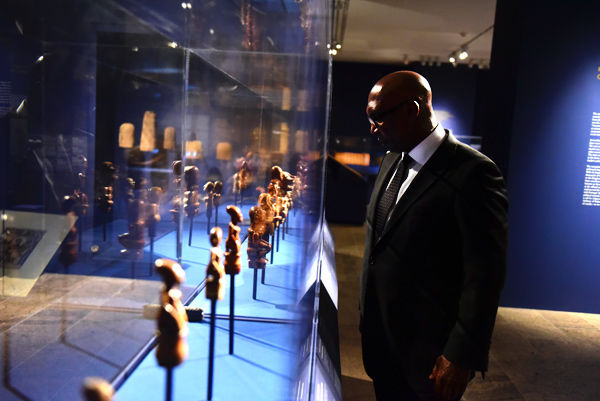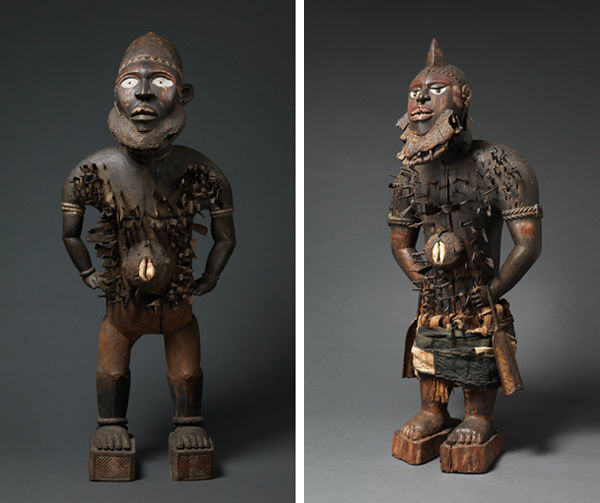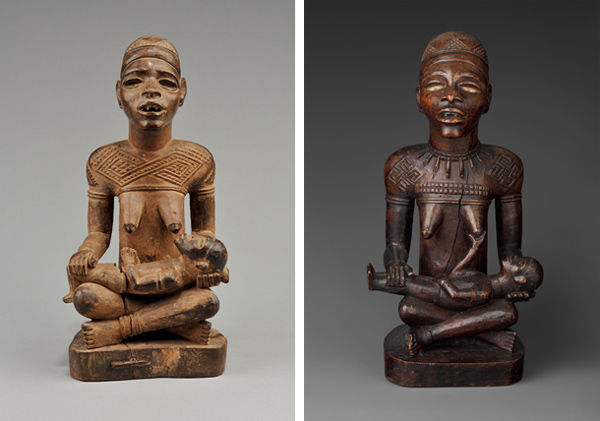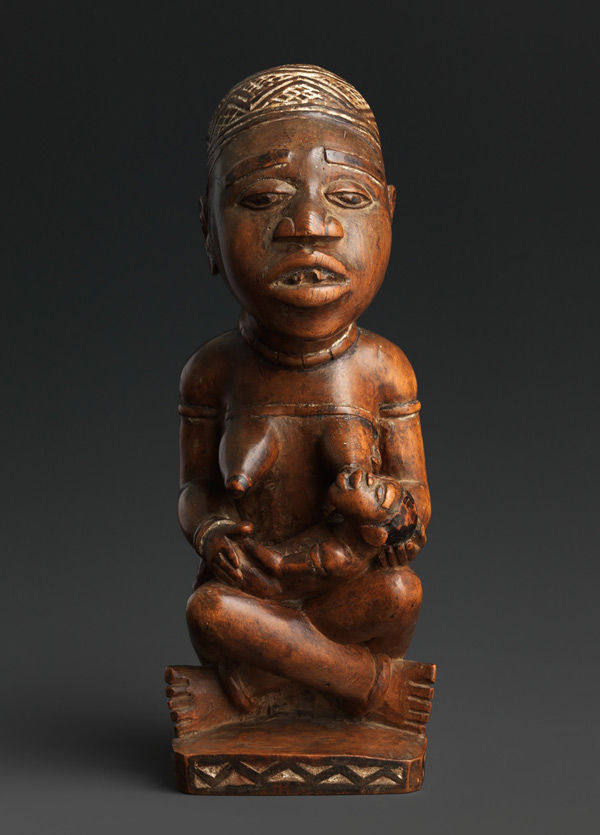
A row of delicately carved ivory finials in the second gallery of Kongo: Power and Majesty. Photograph by Don Pollard
After four years of preparation, and four months of being on view, Kongo: Power and Majesty closed this past Sunday, January 3. I'd like to take the opportunity now to reflect on the exhibition and the enduring impact of Kongo masterworks. I've also invited Lubangi Muniania, senior instructor at Kimpa Vita Institute and President of Tabilulu Productions, to consider the importance of African traditions in the Congo, and their role in museums; his perspective follows my own thoughts below.
Exhibitions are ephemeral in nature. They provide an opportunity to bring works housed in many different institutions together for a limited period of time and to consider them in a focused manner. An objective of this exhibition was to open eyes and minds to the earliest period of direct engagement between Africa and the West and bring it to life through works of art presented in the opening section that were unfamiliar to even the most seasoned specialists in the field of African art history.

Opening gallery of Kongo: Power and Majesty. Photograph by Peter Zeray
The dazzlingly beautiful yet subdued Kongo creations assembled in this modestly sized gallery were a revelation on a number of levels. They represent the majority of the surviving output of Kongo artists before the eighteenth century. To see not one but dozens of examples of these textiles and ivories provided a sense of the concentrated virtuosity commanded by regional carvers and weavers. The pure abstraction of the decorative art forms in chiseled ivory and woven raffia cloth produced during the sixteenth and seventeenth centuries challenged assumptions about the aesthetic that is generally associated with Africa. Their incorporation of formal innovations adapted from European sources—such as suspension lugs and tassels—also made manifest the responsiveness of their authors to ideas introduced from the outside world.

The fifteen Mangaaka figures assembled in the final gallery. Photograph by Peter Zeray
The artistic trajectory we charted established that by the time visitors reached the monumental Mangaaka figures positioned in the final gallery, the groundwork had been laid to appreciate that the nineteenth-century authors of those dramatic creations belonged to an artistic tradition that had been globally networked for centuries. Among the other revelations in that culminating section was the distinct character of each of the fifteen Mangaaka featured. Seeing them as part of an artistic and social movement, we experienced them as an unprecedented gathering of sheer greatness and power.
At the same time, we had the opportunity to acquaint ourselves with them as individual guardians of their respective communities. This reflected a creative process in which some fifteen different master sculptors grappled with the challenge of giving form to the same boundless force of law and order. Through their respective imaginations and quotation of a prototype, they released a unique interpretation from the dense mass of an immense tree.
Power Figure (Nkisi N’Kondi: Mangaaka), 19th century. Kongo peoples; Yombe group, Chiloango River region, Democratic Republic of the Congo, Republic of the Congo, or Cabinda, Angola. Wood, iron, resin, ceramic, plant fiber, textile, pigment; H. 46 1/2 in. (118 cm), W. 19 1/2 in. (49.5 cm), D. 15 1/2 in. (39.4 cm). The Metropolitan Museum of Art, New York, Purchase, Lila Acheson Wallace, Drs. Daniel and Marian Malcolm, Laura G. and James J. Ross, Jeffrey B. Soref, The Robert T. Wall Family, Dr. and Mrs. Sidney G. Clyman, and Steven Kossak Gifts, 2008 (2008.30)
Today, as a result of Kongo: Power and Majesty, we will never view the Mangaaka figure in the Metropolitan's collection with the same eyes.

Left: Power Figure (Nkisi N'Kondi: Mangaaka), 19th century, inventoried 1898. Kongo peoples; Yombe group. Chiloango River region, Cabinda, Angola. Wood, iron, resin, ceramic, plant fiber, textile, pigment, cowrie shell, animal hide and hair; H. 46 1/2 in. (118 cm). Manchester Museum, University of Manchester. Right: Power Figure (Nkisi N'Kondi: Mangaaka), 19th century, inventoried 1906. Kongo peoples, Yombe group. Chiloango River region, Democratic Republic of the Congo, Republic of the Congo, or Cabinda, Angola. Wood, iron, resin, cowrie shell, animal hide and hair (monkey?), ceramic, plant fiber, textile, pigment; H. 44 1⁄8 in. (112 cm), W. 18 7⁄8 in. (48 cm), D. 14 1⁄8 in. (36 cm). MIBACT — Polo Museale del Lazio, Museo Preistorico Etnografico Luigi Pigorini, Rome
Over the four months, we've become acquainted with the figure now in residence in Manchester, with its strong face and broad torso framed by the surprisingly elegant arc of an arm at either side, as well as his counterpart now in Rome, with his slighter build and fine facial features. The fact that each of these figures addressed a unique series of challenges that confronted its populace was materially articulated through the concentration of hardware added to its torso. In parallel, their fragmentary condition—the result of the deliberate removal of elements of consecrated matter—represents calculations by fifteen different caretakers to diffuse the work's potency in anticipation of its removal.
While the works that populated the final gallery of Kongo: Power and Majesty all attested to the socially responsive nature of Kongo art, the dialectic provided by the intimate-scale female representations and those of the close-to-lifesize Mangaaka defenders provided a study in contrasts.

Three distinct groupings of sculpted women allow for the consideration of both a conceptual theme and artistic style. Photograph by Peter Zeray
The three clusters of regal seated women literally holding the future of Kongo communities in their arms was presented in parallel to the dramatic spectacle of the defiant Mangaaka battalion. The first series of seated women embodied the sheer range of approaches introduced by Kongo sculptors to define these women as forces for the revitalization of their communities. The second two groupings underscored the consistent excellence of the surviving works attributed to the Masters of Boma-Vonde and Kasadi. Through the assembled works created by each of these visionary sculptors, one got a sense of their individual voices.
Master of the Boma-Vonde Region. Figure: Seated Female Nursing Child, 19th–early 20th century, inventoried 1913. Kongo peoples; Yombe group, Boma-Vonde region, Democratic Republic of the Congo. Wood, kaolin; H. 9 3/8 in. (23.7 cm), W. 3 1/4 in. (8.2 cm), D. 4 in. (10.1 cm). MIBACT — Polo Museale del Lazio, Museo Preistorico Etnografico Luigi Pigorini, Rome (84209)
All the creations by the Master of Boma-Vonde were defined by the same tender interaction and nurturing intimacy between a woman and her vulnerable infant. Difficult to discern in photographs, the detail that is apparent in the close scrutiny afforded by firsthand viewing is his articulation of the delicate arm of the infant reaching around the side of its mother's breast.

Left: Master of Kasadi. Figure: Seated Female Supporting Figure with Clasped Hands (Phemba), 19th–early 20th century, inventoried 1937. Kongo peoples; Yombe group, Kasadi village, near Tshela, Democratic Republic of the Congo. Wood (Nauclea latifolia Smith), glass, kaolin; H. 10 5/8 in. (27 cm), W. 5 3/8 in. (13.6 cm), D. 4 3/4 in. (12 cm). Royal Museum for Central Africa, Tervuren, Belgium (EO.0.0.37964). Right: Master of Kasadi. Figure: Seated Female Supporting Figure Clasping Her Breast, 19th–early 20th century. Kongo peoples; Yombe group, Democratic Republic of the Congo, Republic of the Congo, or Cabinda, Angola. Wood, glass, kaolin; H. 10 3/4 in. (27.3 cm), W. 5 3/4 in. (14.6 cm), D. 5 in. (12.7 cm). Collection of Drs. Daniel and Marian Malcolm, Tenafly, New Jersey
The nature of the interactions between the seated woman and the secondary figure that extends across the lap of the Master of Kasadi's works are far more varied. They range from a passive detachment to a sexually charged dynamic. The cerebral quality of this artist's analytical approach gives his output a more experimental dimension. Direct confrontation with this body of work makes apparent that what on the surface seems like a familiar subject at first glance is far more complex.
Visit to the exhibition with Alisa LaGamma by members of the New York City Chapter of 100 Black Women, December 2015. Image courtesy of Reverend DeForest Raphael
All those who had the opportunity to take in the grandeur of this Kongo artistic output will have responded in different ways. It has been a privilege to share Kongo: Power and Majesty with visitors both local and international this season, from gifted students to visionary contemporary artists and diplomats. It is unlikely that this corpus will be assembled again in the near future. A generation ago, the National Gallery of Art in Washington, D.C. introduced the coherence of a Kongo worldview through its 1981–82 exhibition The Four Moments of the Sun: Kongo Art in Two Worlds. This initiative at the Metropolitan reflects an ongoing growth of scholarship that has expanded upon that foundation over the past thirty-four years to reveal new dimensions of the greatness of the Kongo artistic legacy.
Far Away from Home
Lubangi Muniania, Senior Instructor at Kimpa Vita Institute and President of Tabilulu Productions
The postcolonial city of Kinshasa seemed as normal as any city in the world until Mobutu Sésé Seke, the president of Congo-Kinshasa [the Democratic Republic of the Congo], introduced his revolution, "Authenticité" (or Zairianisation), a movement that allowed Congolese to reclaim their ancestors' ways. In the late 1960s and early 1970s, Mobutu proposed it to become the country's ideology for the nation's best interest.
The fear was greater than the reality. The movement introduced us to the Africa we never knew in the city. Deep conversations regarding spirituality, traditions, music, dances, and philosophies took place in traditional languages. It was like a reset button, as we met grandparents who for more than eighty years couldn't enter the urban areas unless a pass was issued under colonial rules.
After my education, I understood the difference as an educator at museums in the United States. My experience with museum exhibitions of traditional African art has helped me to understand that a typical exhibition is centered on works of art made by unknown artists, which often represent a period between the nineteenth and early twentieth centuries. Well, this isn't to say that there aren't exhibitions with much older works of arts by traditional African artists; I'm simply saying that a typical traditional African-art exhibition is strictly about African ideas embodied in these objects.
There are many possible narratives when creating an exhibition about African art, but three major aspects of it have stood out throughout this exhibition: the historical, political, and, of course, the artistic.
Let's take the historical. It is a big revelation to many viewers that a work of art by an African artist from the ancient Kingdom of Kongo already reached European collections only a few decades after Christopher Columbus set foot in the Americas. In terms of perspective, the shameful transatlantic slave trade had not yet started, and all the nations of today in the Americas were not even a thought in the minds of many. By the way, this was Renaissance Europe collecting African artifacts, exquisite craftsmanship made of precious materials like ivory, which made them worthy gifts for royals in Portugal and elsewhere in Europe. Apart from African arts being found in royal cabinets of curiosity, there were also African arts in papal collections back then.
Then the political. Look at European paintings of Kongo people in the exhibition like the one of Diego Bemba, the servant of Don Miguel de Castro (Emissary of Soyo, Kongo), and the dutch ambassadors at the court of Garcia II, King of Kongo.
Attributed to Jaspar Beckx (Dutch, active 1627–47), formerly attributed to Albert Eckhout (Dutch, ca. 1610–1666). Portrait of Diego Bemba, Servant of Dom Miguel de Castro, Emissary of Soyo, ca. 1640–47.Oil on panel; 29 1/2 x 24 3/8 in. (75 x 62 cm). Statens Museum for Kunst, Copenhagen (KMS9)
Olfert Dapper (Dutch, 1635–1689). Dutch Ambassadors at the Court of Garcia II, King of Kongo. Engraving. From O[lfert] Dapper, Naukeurige Beschrijvinge, p. 580
All evidence suggests that in this period Europeans and Kongo citizens did not perceive each other as fundamentally different. This explains why the King of Kongo adopted Christianity from a newfound civilization, Samputu, or "adopting ways of Europe." It was only in the seventeenth century that an ugly ideology had begun to change this sense of a deep commonality. A growing transatlantic slave trade made it expedient for Europeans to view Africans as less than human, hence domination and exploitation followed soon after.
Finally, we consider the artistic. Through Kongo: Power and Majesty, viewers can appreciate the arts and creative minds of Kongo artists. Look at patterns on the luxury cloth cushion covers and these on the exceptionally elegant oliphants. The Nkutu, or top garment, made out of pineapple fiber, was once worn by an Mfumu Nsi or a regional governor in Kongo Dia Ntotila. That garment shows renderings of traditional patterns with finesse and delicacy.
Garment (Nkutu), 19th century, inventoried 1897. Kongo peoples; Cabinda, Angola. Pineapple fiber (Ananas sativus Schult.), sedge fiber (Cyperus rotundus Linn.), pigment; H. 25 5/8 in. (65 cm), W. 39 in. (99 cm). Museu da Ciência da Universidade de Coimbra, Portugal (ANT.Ang.282)
I think this evidence of extremely complex minds, virtuoso, geometry, rhythmic order, and mastery over technique should be seen by both twenty-first-century Africans in and outside the continent, but these powerful and majestic objects are still far away from home.





